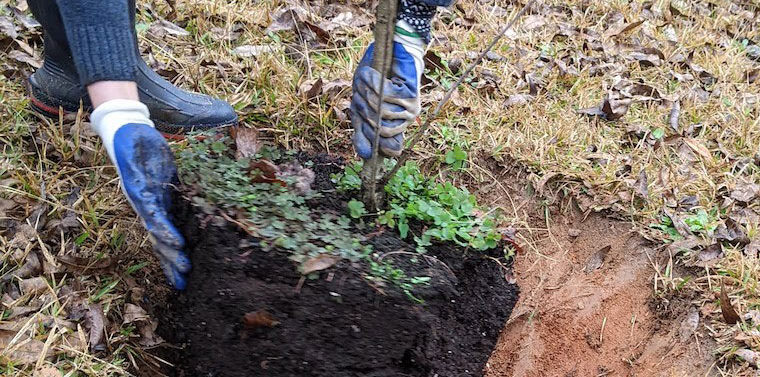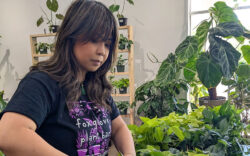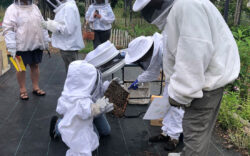I know some folks dream of a snowy winter, but here in Georgia, I’m thinking about trees—and not just the decorated Christmas variety.
Winter is the best time to plant trees and larger woody shrubs in the South. Our ground doesn’t freeze solid like it does in the great frozen tundra that is the North, and with relatively wet winters, you don’t have to worry about remembering to water until the spring. Planting dormant trees gives the saplings an opportunity to slowly grow roots without spending additional energy on leaves and flowers.
Pick trees that fit your locations: Here in the Athens-area, our growing zone is 8A. Only choose outdoor plants fit for that zone. Pick trees based on your environment and do a few book- or internet-based searches to find what’s likely to work best for home and wallet. Dogwoods, for example, bloom best in the full sun, but survive best in the partial shade of a larger tree. Ginkgos shine gold in their fall coloring, and they demand a much higher price because of their popularity. The pawpaw, a native Georgia fruit tree, can set its banana-flavored fruit in the shade, but the flowers smell of rotten meat to attract its preferred pollinators.
Plant the right size tree: I buy larger trees when I can find a good deal. Otherwise, I buy small (1–2 foot) bare root saplings. The stick-like plants grow slowly in pots on my porch for a year or two before they move into their final homes in the ground. The Arbor Day Foundation recommends planting bare root saplings much like the larger trees. With bumbling puppies, munching goats, pecking chickens and plenty of hungry, roaming deer, I’ve found it easier to protect saplings on the porch to give them a fair shot at surviving.
Watch out for right-of-ways: Georgia Power gets 10 feet on each side of its primary electric lines as right-of-way. The secondary line (the one to your house) is your responsibility. Forestry crews come out every couple of years to hack back greenery touching or near the primary line. One apple tree wasn’t far enough away and died because its roots were smashed by heavy machinery driving across them. I have three more apple trees to move this winter because I didn’t think of this. And it’s not just Georgia Power. Road crews can spray herbicides and cut back vegetation obscuring drivers’ views. Any trees planted near a septic line or tank is a bad idea, too. Remember to call 811 before you start digging holes to avoid costly mistakes. My mom sliced the power lines to our house—twice—in the thrall of an exciting gardening project she couldn’t wait to start. I promise, it’s worth it to double check.
Dig out, not down: Ready to start shoveling? Aim for digging at least two times the width of the sapling’s pot. The Arbor Day Foundation recommends a hole three to four times wider than the tree’s container. Keep the hole’s depth to how deep the tree is nested in its current container. On the whole, tree roots need more space to spread out than down.
Mulch it, mulch it good: This is one step I’ve tried to skip, and found it necessary. The mulch protects the saplings’ roots from the widely varying temperatures of a climate change-affected winter and suppresses weeds. I use 3–4 inches of wood chips and spread it about 3 feet wide around the base of the tree. Avoid making a mulch volcano, and do not cover the base of the trunk with mulch. This can cause rot and disease. Leave at least an inch or two of space between the trunk and the mulch.
Potting it up: Don’t have a yard? You can still care for a tree. You will need enough space for a very large pot, so this won’t work for the smallest of gardens. While there are plenty of online suggestions, I think Japanese maples are the way to go if you’re in the market for a single tree. They pack a pretty punch, waving beautifully colored, lacey leaves on sometimes red, pink or purple bark. Some varieties are smaller than others, but almost all grow slowly.
Watering year-round: A sapling needs steady irrigation, about 1 inch a week, during its first year in the ground. Georgia’s wet winters usually take care of three months of watering for me. Come April, I’ll install a soaker hose across my newly planted trees and run it 2–3 hours about twice a week, depending on rainfall.
If you’re interested in learning more, or watching a video on how to plant a tree, visit the Arbor Day Foundation website at arborday.org.
Like what you just read? Support Flagpole by making a donation today. Every dollar you give helps fund our ongoing mission to provide Athens with quality, independent journalism.










